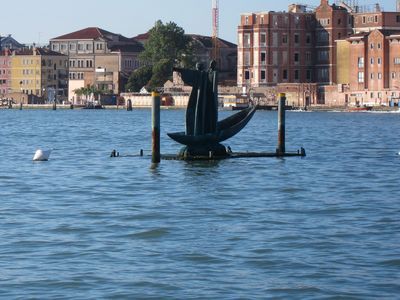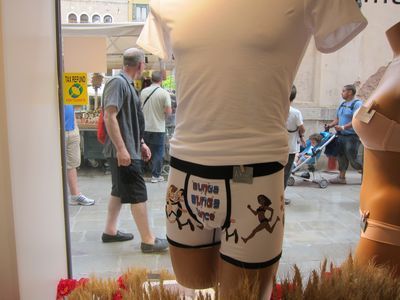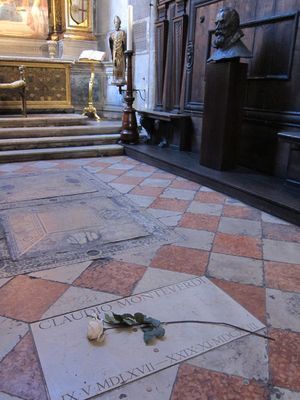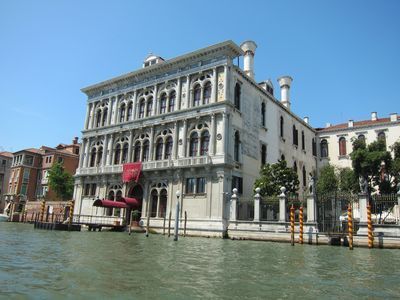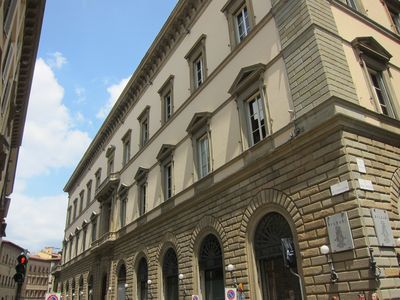Alex Ross's Blog, page 228
June 28, 2011
Rome on the march
June 27, 2011
At the graves of Stravinsky and Nono
Yesterday I took a vaporetto out to San Michele, the cemetery island of Venice. It was seven-thirty on a Sunday morning, and my only fellow passengers were several elderly people whom I took to be widows and widowers, bearing flowers for their loved ones. I was preparing to pay my respects to Igor Stravinsky, who loved Venice and held the premieres of The Rake's Progress, Canticum Sacrum, and Threni in the city. On April 15, 1971, a lugubrious gondola bore Stravinsky's coffin to San Michele; he was buried a few paces from the grave of Diaghilev, in the Orthodox section of the cemetery. If Diaghilev's tomb is a bit on the gaudy side, Stravinsky's, like Mahler's in Grinzing, is forcefully simple: a horizontal slab with the composer's name across the top and a cross toward the bottom. Vera Stravinsky is beside him, her grave identical in design. (I omit pictures out of respect for the cemetery's policy of not allowing photography. The shot above shows Dante's Boat, a Georgiy Frangulyan sculpture that was installed in the waters near San Michele during the 2007 Biennale and seems to have become a permanent fixture.) A recent visitor had left a piece of paper on which was written the famous E-flat/F-flat dissonance from the Rite. Unable to improve upon that gesture, I placed a pebble among dozens already resting on the slab and thought of what Stravinsky said when Diaghilev asked him how long those chords would go on: "Till the end, my dear."
I walked on to the Protestant section, which holds Emanuel Wolf-Ferrari, Joseph Brodsky (a recent mourner had left a fedora), and Ezra Pound, occupying a bushy, inconspicuous plot with his companion Olga Rudge. Feeling that Pound seemed overlooked, I scribbled three favorite lines on a piece of notebook paper and offered them up:
Do not move
Let the wind speak
that is paradise
The words fit the warm, still air of Sunday morning. Finally, after some minutes' search, I found Luigi Nono, whose monument is beautiful and austere: a rough, irregular piece of rock at the head of a bed of ivy. Here, too, I placed a pebble, though the gesture seemed intrusively sentimental.
Perhaps I should try to explain this morbid habit of visiting composers' graves. In the summer of 1995, I made my first trip to continental Europe, writing up my travels for the New York Times. (Eternal thanks to John Rockwell for urging me to go, and to Jim Oestreich for publishing the results; my account of music and World War II became the kernel of The Rest Is Noise.) It occurred to me that I could tie together the summer by describing how composers are commemorated in different countries, and so I patronized the relevant cemeteries in each city on my itinerary. I don't think the piece is one of my best efforts, but I have fond memories of the curious, meandering journey that it records. On my current Italian sojourn, I've been catching up with some eminences I missed in 1995. I still have yet to see the master of them all, the one in Leipzig.
Previously: At the graves of Monteverdi, Frescobaldi, Zemlinsky, Schnittke, Fibich, X. Scharwenka, Enescu, Rachmaninov.
Obligatory bunga-bunga post
Berlusconi's famous parties, brilliantly and savagely detailed in a recent article by Ariel Levy in The New Yorker, have inspired a line of underwear. I don't understand Italian politics well enough to judge whether this is a good or bad sign for the prime minister.
June 25, 2011
At the grave of Monteverdi
Off-topic (update)
Thank you, New York State Senate, for supporting equality!
June 23, 2011
Death in Venice
The Palazzo Vendramin-Calergi on the Grand Canal. The Wagners took up residence in the mezzanine apartment in September 1882; the room where the composer died, on Feb. 13, 1883, is on the right side. The building is now occupied by the Casino di Venezia — "An Infinite Emotion" is their slogan — but the Associazione Richard Wagner di Venezia maintains an excellent small archive in Wagner's private rooms.
June 22, 2011
Birthplace of opera
The Palazzo Corsi in Florence, where Jacopo Peri and Ottavio Rinuccini's Dafne had its first performance in 1598, is now known as the Palazzo Tornabuoni and is home to a Four Seasons residence club. I'm told that Susan Graham, who is singing splendidly in L'incoronazione di Poppea at Maggio Musicale, succeeded in talking her way inside to see the place; I did not.
June 21, 2011
Make Music NY
I'm missing this year's edition because of my month-long Roman residency, but I'm hoping that thunderstorms skip the city today. Some highlights: John Luther Adams's Inuksuit in Morningside Park at 5PM (my review of the indoor edition here); Yoko Ono's Secret Piece at sunrise; Julian Day, Luke Jaaniste, and Janet McKay's brass happening SWELTER on Central Park Lake (3:30PM and 5PM); Nick Franglen's Hymn to the Manhattan Bridge all day; Aaron Siegel and Larry Legend's iPhone project GROUP at 12:45PM on Wall Street; and Andriessen's Hoketus in the same place at 1PM. Enjoy!
June 20, 2011
New Yorker per uomo
I'm not entirely sure if this T-shirt is officially authorized, but it's good to see the magazine represented in a storefront on the streets of Sansepolcro, birthplace of Piero della Francesca.
June 15, 2011
Another Bloomsday post
Luciano Berio's Thema (Omaggio a Joyce), based on the opening of the "Sirens" chapter of Ulysses.
Previously: Bloomsday post, Wagner/Joyce.
Alex Ross's Blog
- Alex Ross's profile
- 425 followers


